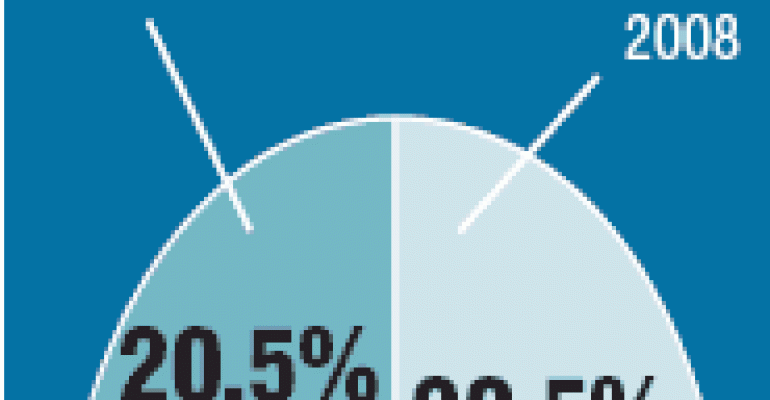
In a fourth-quarter earnings conference call with investors, Steve Burd, chairman, president and chief executive officer, Safeway, Pleasanton, Calif., said consumers have become “more cautious.”
“I think some of that caution stems from the fact that they are a little bit concerned about the economy,” he said. “Everybody is forecasting some kind of recession, and then we have an unusual situation where you add to that the uncertainty of more inflation than consumers have seen in some time. We see some evidence of consumers trading down.”
He said the trading down has been visible in the weakened demand for high-end merchandise, such as premium wine, and also in the increased demand for private label across many different food retailers.
Safeway generally passed on product-cost inflation quickly to consumers, Burd said, although occasionally there is “a little bit of lag.” Sometimes Safeway is able to protect its gross margins, he said, while other times it is only able to “protect pennies of profit.”
Still, he advised analysts that they should view inflation as a “neutral event” for supermarkets because of the offsetting gains from consumers who have cut back on restaurant spending and the increased sales of private-label products.

He likened the current inflationary environment to what food retailers have always dealt with in their produce departments, where rapid swings in price are commonplace.
“It is challenging,” he said. “But we don’t see it as a problem that can’t be managed.”
Many supermarket companies have indicated that they are benefiting from what Deborah Weinswig, an analyst at Citi Investment Research, New York, called “trading in,” the phenomenon retailers have described as occurring when consumers cut down on dining out in favor of eating more meals at home.
In the SN survey, more than 90% of the respondents said they felt their customers were eating more meals at home to save money, with 52.3% saying they felt consumers were adding “a few meals here and there” at home instead of going to restaurants, and 38.6% saying they believe that their customers “have cut back significantly on dining out.”

Weinswig, in a conference call with investors last week discussing the topic of trading down as it relates to retailers, restaurants and CPG companies, cited recent research from the USDA that indicated an increase in at-home dining at the expense of restaurants.
In 2007, she said, food-at-home expenditures increased as a percentage of overall food spending for the first time since 2001, reaching 53.2%.
“More significantly,” she added, “food-at-home share increased 210 basis points over the 51.1% in ’06. That’s the highest year-over-year increase since the 1940s.”
January data indicate the proportion of food spending for at-home dining increased even more in January, to 54.6%, she noted.
“Some of the ‘trading in’ phenomenon has to do with supermarkets improving their ready-to-eat meals, combined with higher prices at the restaurant and higher gas prices, since consumers would rather just stay at home and eat, as opposed to making another trip,” she said.
Delhaize Group, the Brussels-based parent of Hannaford Bros., Food Lion and Sweetbay in the U.S., said in reporting its results for the fourth quarter earlier this month that it has been seeing some evidence that consumers are spending more on prepared foods and frozen dinners, indicating a shift away from restaurant spending.
Jeff Noddle, chairman and CEO, Supervalu, Minneapolis, said he also believes the current economic environment may create an “opportunity” for supermarket operators.
“I think the restaurant business is going to be more stressed because of this,” he said.

He said it is still too early to accurately predict how consumers will behave as the year progresses, however.
“It doesn’t feel to me like [the country is in a recession] yet, but now that we are past the holidays, I think the next few months will be very telling in terms of how the consumer feels about their outlook and their position,” Noddle said.
Glen Petraglia, a Citi Investment Research analyst who follows the restaurant industry, said he believes restaurants began to see the first signs of trading in toward more at-home dining last year when gas prices began to spike. With some observers projecting that gas will hit $4 per gallon this summer, analysts expect consumers to continue to cut back on their driving.
In the SN survey, more than 90% of respondents said they believe consumers have cut down on their shopping trips to outlying destinations because of high gasoline costs, with 15.9% saying consumers have cut back “significantly” on these trips.
Retailers still expect their top lines to be buoyant in 2008. According to the SN survey, only 11.4% of retailers said they expect their average basket sizes to be smaller in 2008 than in 2007, and 45.5% said they expect bigger baskets.
Only 6.8% of respondents said they expect all of their sales growth to come from inflation — 54.5% said less than half of their sales growth will be inflation- generated, while 31.8% said more than half of their growth will result from inflation.
In January, overall food inflation was 4.9% higher than the prior-year period, and food-at-home prices rose 5.8%, according to data from the U.S. Department of Labor.





